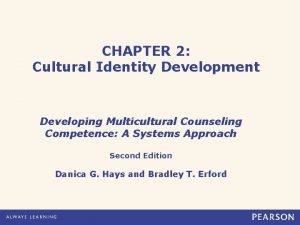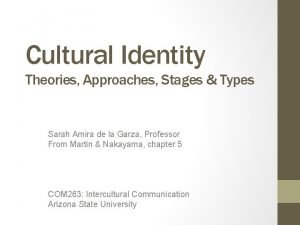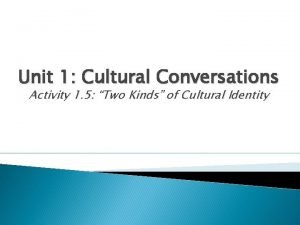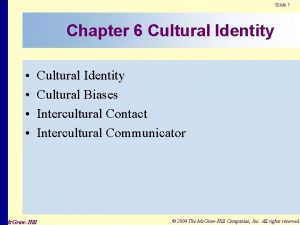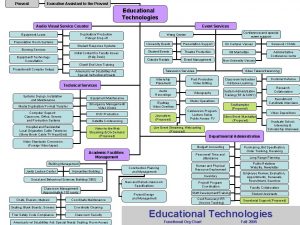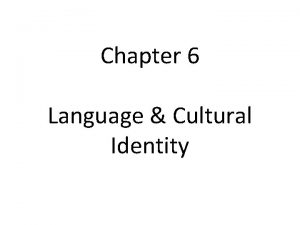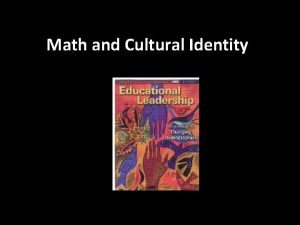Cultural Identity Dr W Terrell Jones Vice Provost


















- Slides: 18

Cultural Identity Dr. W. Terrell Jones Vice Provost for Educational Equity The Pennsylvania State University www. equity. psu. edu


Six Observations 1. All of us have multiple identities, some of which we may identify with more than others. 2. We often experience contradictory urges or needs for a sense of belonging or "fitting in" as well as a feeling of uniqueness or specialness. 3. Some differences or identities exact a higher and/or different price for the bearer in a particular societal, historical, or situational context.

Six Observations continued 4. Some individuals have a choice of becoming recognized as members of a particular identity or choosing to remain anonymous. 5. Individual identities are always changing and developing. 6. The development of an individual identity does not preclude the development of shared goals and purpose.


Summary of Some Characteristics of White Racial Identity Ego Statuses Adapted from J. E. Helms, 1992 Types of Ego General Description Status Behavioral-Cognitive Dimensions Contact Naiveté, obliviousness to sociopolitical implications to race Has difficulty consciously thinking of self as White; claims to be colorblind and thinks it a positive attribute Disintegration Disorientation and confusion First conscious acknowledgement of the value of being White; awareness of racial moral dilemmas is salient

Summary of Some Characteristics of White Racial Identity Ego Statuses Adapted from J. E. Helms, 1992 Type of Ego Status General Description Behavioral-Cognitive Dimensions Reintegration Endorsement of White superiority and supremacy is guiding theme Displaced anger and hostility toward people of color is in the forefront; identity is maintained by increasing White privilege

Summary of Some Characteristics of White Racial Adapted from J. E. Helms, 1992 Identity Ego Statuses Type of Ego Status General Description Behavioral-Cognitive Dimensions Pseudoindependence Intellectualized acknowledgement of implications of racialgroup membership; feels responsible for “helping” the less fortunate groups become more like Whites Attempts to resolve racial tensions by feeling guilty; believes that racism is not personally relevant if one has a friend of color; contends that racism is engaged in only bad Whites

Summary of Some Characteristics of White Racial Identity Ego Statuses Adapted from J. E. Helms, 1992 Type of Ego Status Immersion and emersion Autonomy General Description Behavioral-Cognitive Dimensions A search to define and abandon personal racism and to define a nonracist White identity Attempts to help Whites understand their role in perpetuating racism; tries to build a network of nonracist Whites Racial humanism; internally defined nonracist identity; valuing of racial diversity Seeks opportunities to increase the diversity in his or her life; does not force White culture on others

Five Functions of Identity 1. Buffering Function Refers to those actions that allow for psychological protection and self-defense against everyday encounters with racism Serves as a shield against unavoidable or unsuspected racist encounters Can also be applied or used in ways that block or limit opportunities for development and growth

Five Functions of Identity 2. Bonding Function Relates to the degree to which a person derives meaning and support from affiliation with or attachment to people of one’s race and one’s culture

Five Functions of Identity 3. Bridging Function Refers to abilities associated with being comfortable moving back and forth between one’s own culture and that of another A person with this function can experience high levels of comfort and joy with opportunities to learn about other cultures and in sharing with and educating others

Five Functions of Identity 4. Code-switching Function An ability to temporarily accommodate to norms and regulations of a group, organization, school, or workplace A natural defense for situations where other groups express uneasiness with different norms and values

Five Functions of Identity 5. Individualism Function An expression of one’s uniqueness One’s individual personality allows one to act in a race-neutral fashion in accord with individual norms, likes, and dislikes

Racial/Ethnic Identity Development Models and Statuses From Cross, 1971, Atkinson, Morten, and Sue, 1989, 1990, and Helms, 1992 Negro-to. Black Minority Identity Development Composite Description Pre-encounter Conformity Minimization of membership or denigration of one’s own as well as other visible racial and ethnic groups*; idealization of Whites and White culture Encounter Dissonance Disorientation and confusion regarding own-group and majority-group affiliation and appreciation * Refers collectively to Asian, Black, Native, and Hispanic Americans of color

Racial/Ethnic Identity Development Models and Statuses From Cross, 1971, Atkinson, Morten, and Sue, 1989, 1990, and Helms, 1992 Negro-to. Black Minority Identity Development Immersion and Resistance emersion and immersion Introspection Composite Description Idealization of one’s own visible racial and ethnic group* and physical and psychological withdrawal into one’s own group; rejection and denigration of “Whiteness” Search for more rational group selfdefinition and more balanced intergroup relations * Refers collectively to Asian, Black, Native, and Hispanic Americans of color

Racial/Ethnic Identity Development Models and Statuses From Cross, 1971, Atkinson, Morten, and Sue, 1989, 1990, and Helms, 1992 Negro-to. Black Internalization and commitment Minority Identity Development Integrative Awareness Composite Description Positive sense of visible racial and ethnic group* self, capacity to value and respect other racial and ethnic groups Recognition of shared oppressions with broad range of societal groups and the will to promote change * Refers collectively to Asian, Black, Native, and Hispanic Americans of color

Cultural Identity Dr. W. Terrell Jones Vice Provost for Educational Equity The Pennsylvania State University www. equity. psu. edu
 Global penn state
Global penn state Terrell ward bynum
Terrell ward bynum Tammi terrell thomas montgomery
Tammi terrell thomas montgomery Britanica encylopedia
Britanica encylopedia Maria terrell
Maria terrell Olivia terrell
Olivia terrell Bullying prevention training
Bullying prevention training Maps identity
Maps identity Ruiz's chicano/latino ethnic identity model
Ruiz's chicano/latino ethnic identity model Cultural identity development models
Cultural identity development models Two kinds of cultural identity activity 1.5 answer key
Two kinds of cultural identity activity 1.5 answer key Cultural identity development models
Cultural identity development models Cultural identity context clue
Cultural identity context clue Cultural identity and biases
Cultural identity and biases Cultural identity
Cultural identity Cultural identity
Cultural identity Senior regional vice president
Senior regional vice president Senior regional vice president
Senior regional vice president The inherent vice of capitalism
The inherent vice of capitalism








